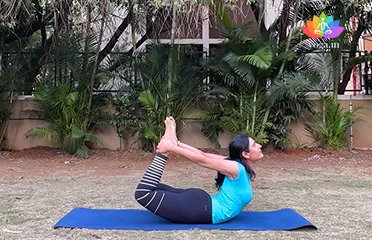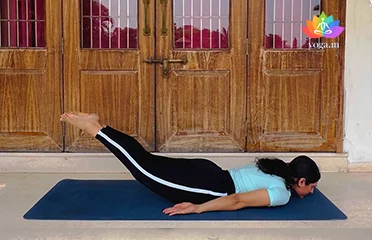Dhanurasana (Bow Pose)
धनुरासन / Bow Pose
The Sanskrit name is derived from Dhanur (धनुर) means bow and Asana [�K]
Shalabhasana (Locust Pose)
सलभासन / Locust Pose
The Sanskrit name is derived from Shalabha (शलभा) meaning locust and [�K]
How Yoga Can Help Cure Polio:
Polio, or poliomyelitis, is a viral disease that can cause paralysis and muscle weakness. While there is no cure for polio, yoga can help manage and alleviate its symptoms. Through gentle physical postures, breathing exercises, and relaxation techniques, yoga can enhance physical strength, improve mobility, and reduce stress, which is beneficial for those recovering from polio.
Understanding Polio:
Polio is an infectious disease caused by the poliovirus, which primarily affects young children. It spreads through contaminated water and food and can invade the nervous system, potentially causing permanent paralysis. There are three types of polio: non-paralytic, which causes flu-like symptoms; paralytic, which can lead to muscle weakness and paralysis; and post-polio syndrome, which can occur years after the initial infection.
Yoga’s Role in Relieving Polio:
Yoga can be instrumental in managing the long-term effects of polio. Specific yoga practices can help strengthen muscles, enhance flexibility, and improve overall mobility. Additionally, pranayama (breathing exercises) can support respiratory health, and meditation can help reduce stress and promote mental well-being.
Key Factors Contributing to Polio:
Several factors can contribute to the spread and impact of polio, including:
- Lack of Vaccination: Not receiving the polio vaccine increases the risk.
- Contaminated Water and Food: Consuming contaminated water or food can lead to infection.
- Poor Sanitation: Inadequate sanitation facilities can facilitate the spread of the virus.
- Weakened Immune System: A compromised immune system can make individuals more susceptible to the virus.
Symptoms of Polio:
Common symptoms of polio include:
- Fever: A sudden rise in body temperature.
- Fatigue: Feeling extremely tired and lacking energy.
- Headache: Persistent pain in the head.
- Vomiting: Expelling stomach contents through the mouth.
- Stiffness: Stiffness in the neck and back.
- Muscle Weakness: Weakness in muscles, particularly in the legs.
- Paralysis: In severe cases, loss of muscle function and paralysis.
Treatment of Polio through Yoga and Pranayama:
Yoga and pranayama can play a crucial role in the rehabilitation of polio survivors. Some beneficial practices include:
Specific Yoga Poses:
Tadasana (Mountain Pose): Helps improve posture and balance.
- Stand with your feet together and arms at your sides.
- Inhale, raise your arms overhead, and stretch upward.
- Hold for 30 seconds to 1 minute, then release.
Virabhadrasana I (Warrior I Pose): Strengthens the legs and improves balance.
- Stand with feet hip-width apart.
- Step one foot back and bend the front knee, keeping the back leg straight.
- Raise your arms overhead and hold for 30 seconds to 1 minute.
- Switch sides and repeat.
Pranayama Exercises:
Nadi Shodhana (Alternate Nostril Breathing): Balances the nervous system and reduces stress.
- Sit comfortably and close your right nostril with your thumb.
- Inhale deeply through your left nostril.
- Close your left nostril with your ring finger and release the right nostril.
- Exhale through the right nostril.
- Repeat for 5-10 minutes.
Bhramari (Bee Breath): Calms the mind and supports respiratory health.
- Sit comfortably, close your eyes, and place your fingers in your ears.
- Inhale deeply and exhale slowly, making a humming sound like a bee.
- Repeat for 5-10 minutes.
Diet for Polio:
A balanced diet can support recovery from polio. Recommendations include:
- Protein-Rich Foods: Chicken, fish, beans, and lentils to support muscle repair.
- Vitamin C: Citrus fruits and vegetables to boost the immune system.
- Calcium-Rich Foods: Dairy products, almonds, and leafy greens for bone health.
- Hydration: Drinking plenty of water to stay hydrated and support overall health.
Caution for Polio:
While practicing yoga for polio, it is essential to:
- Avoid Overexertion: Practice at a gentle pace to prevent strain on weakened muscles.
- Be Mindful of Pain: Stop immediately if any pose causes discomfort or pain.
Always consult with a healthcare provider before starting any new exercise regimen, especially if you have a history of polio.
Contraindications for Polio:
Individuals with severe polio or significant muscle weakness should:
- Avoid Intense Yoga Practices: Vigorous exercises might exacerbate symptoms.
- Steer Clear of Certain Poses: Poses that require significant muscle strength or balance may not be suitable.
- Seek Professional Guidance: Consult a yoga therapist or healthcare professional for personalized recommendations.



